Review: Fly 1/32 Arado Ar-234B-2
Of all the German jets, the Arado Ar 234 had the easiest transition and least change from prototype to operational aircraft. Once the decision was made to equip the airframe with a standard tricycle undercarriage, which required the widening of the fuselage. There was little if any change onward.
In July 1944, 1.Staffel/Versuchsverband Ob.d.L. took delivery of the Ar 234 V5 and V7 at Juvincourt, near Rheims. These were essentially A series aircraft, using the trolley and skids system for takeoff and landing. The unit used the Rauchgerate (RATO) units for takeoff and the braking parachute for landing. By mid August, the Staffel had flown several successful reconnaissance missions including missions over the Normandy beachhead and Great Britain and experienced no difficulty eluding Allied fighters at an operational altitude of 29 30,000 feet. In late August, the unit took delivery of two Ar 234B 1s, the production recon only sub type. That September, they took two more Ar 234B 1s and returned the V5 and V7 to the RLM, as they became the Sonderkommando Goetz. By November, two other reconnaissance units, the Sonderkommandos Hecht and Sperling, were formed with four Ar 234B 1s each. Also in November, the first Ar 234B 2 bombers were delivered to II/KG 76 at Achmer, with the pilots receiving transition training in time to take part in pinpoint attacks in the Ardennes the next month as the Germans smashed though American lines in what became The Battle of the Bulge.
The recon Sonderkommanos were disbanded at the end of the year, with the crews going on to 1/FernAufklarensGruppe 100, a long range reconnaissance unit. At the same time, I and III Gruppen of KG 76 began reequipping with the Ar 234B 2, though neither unit would ever achieve full strength on the type and their operations would be hindered by the severe fuel shortage the Luftwaffe faced after the successful Allied bombing campaign against the synthetic fuel industry in the previous summer and fall.
By early March, 1945, improvements in fuel supplies allowed the Ar 234B 2s of III/KG 76 to undertake missions against the Ludendorff Bridge at Remagen, which the American Army had seized before it could be destroyed and was using to rush Allied forces across the Rhine into central Germany. The bridge was taken March 7, and survived over 100 attacks by Ar-234B 2s using the 2,205 lb SD 1000 bomb before finally collapsing on March 17.
Three Ar 234B 1s of FAGr 100 were sent as a Sonderkommando to Udine, Italy, in mid March as a result of the constant complaints from the German forces in Italy that they were unable to obtain useful photo reconnaissance with the aircraft available. The three Ar 234s, operating at 29 39,000 feet, radically changed the situation as they operated regularly over the Ancona and Leghorn sectors of the front. Unfortunately, it was again a case of too little too late, as the German forces rapidly collapsed in northern Italy in April.
By the end of March, the Ar 234B 2s of III/KG 76 were immobilized for lack of fuel at Oldenburg, while the remnant of I/KG 76 was at Leck, with II/KG 76 at Scheppern. In the meantime, 1./FAGr.123 and 1./FAGr.33 had received some Ar 234Bs and were based in Denmark. Following the end of the war on May 8, these aircraft were rapidly taken over by British and American forces.
A total of 210 Ar 234Bs were produced during the war. Due to fuel shortages and the confusion that reigned in Germany during the final year of the war, less than two thirds of them were actually delivered to combat units, and less than half were used on operations due to fuel shortages and Allied air domination over the bases they flew from.
One Ar-234B-2 survived to become an exhibit at the National Air and Space Museum.
Previous to this kit, the only large scale Ar-234 was a full resin kit designed by Radu Brinzan and marketed by MDC. It is accurate and pricey. The announcement by Fly that the Ar-234B-2 bomber and Ar-234BN nightfighter would be released gave large scale jet modelers hope of a kit they could afford. The Ar-234B-2 was released in the fall of 2014.
Opening the box, the first thing one notices are the large number of resin parts. The plastic parts are limited run so there is a little bit of flash around the corners and no locating pins. This is not a Tamigawa shake'n'bake kit. Careful test fitting is needed with lots of Mr. Surfacer on all joints. The plastic is hard and sturdy, but is easy to work with. Plastic parts include the fuselage halves, RATO rockets, gear doors and nose wheel. Wing are in upper and lower parts as are the horizontal stabilizer, with a separate rudder. The engine nacelles are in halves, with the rear exhaust body also in plastic halves. The clear parts benefit from being dipped in Future.
The cockpit comes with plastic side consoles and resin rear bulkhead, seat, control yoke, bomb sight, and side panel and oxygen control. The instrument panel is in plastic. The seat belts and rudder pedals are photo-etch.
The gear wells are resin, while the gear doors and the landing gear itself is plastic with some resin and photoetch parts for the nose wheel. The wheels are each two-part plastic pieces. The resin parts are really excellent and include the parachute packs for the RATO units.
Decals are by Bodecek Agency, which is known for good airliner decals. Decals are provided for four aircraft. One from a test unit, one from KG 76 and one each as tested by the US and Britain post-war.
I began construction starting with the assembly of wings and horizontal stabilizers. I then assembled the engine nacelles, which have a resin intake part for each. The small intakes on the nacelle are separate plastic parts. I attached the nacelles to the wings and applied Mr. Surfacer to the wing-nacelle joints.
I then cut the main gear wells which are resin off their backing, cleaned them up and attached them in each fusleage half after test-fitting in insure they would allow the fuselage to close up. I also attached the bomb holder, then glued the fuselage together and set it aside.
The cockpit parts were painted Tamiya German Grey and then detailed, with the separate instrument decals provided, and some highlighting done with a Prismacolor silver pencil. I painted the seat belts, assembled them and attached them to the seat. I then assembled the rest of the cockpit in accordance with the instructions and glued that separate assembly together. I attached the resin nosewheel well in position and then taped the wings in position and glued in sufficient fish weights to insure nose sitting, then glued the cockpit to the fuselage. The join again required Mr. Surfacer.
After sanding the joints smooth and rescribing the petite panel detail where necessary, I attached the wing and stabilizers. These also required Mr. Surfacer for the joints.
The instrument panel has separate resin instrument cans. I drilled the back of these and then glue pieces of solder to them, to use for the wiring. Rather than have the wiring going everywhere as was often the case, I wrapped the wires together, as I found in one photograph of an Ar-234. I then attached the instrument panel and then glued the clear parts in place. Again, Mr. Surfacer would be needed for the joins, but I waited to apply that until I had masked the canopy, then carefully applied the filler and sanded it smooth.
I painted the canopy framing black, then masked all that. I preshaded panel lines, then painted the jet exhaust with Alclad Steel, which I then masked. The model was camouflaged per the painting diagram, using Tamiya paints mixed to be RLM 81/82/76.
When it was finished, I gave the model a coat of Future.
The kit decals were used throughout, other than the “F1" to do a III/KG 76 airplane, which came from an Xtradecals sheet. The decals gave no trouble under an application of Micro-Sol.
I assembled the landing gear and painted it RLM02, then attached each in its respective gear well, then attached the gear doors after attaching the wheels to the gear legs. With the model on its feet, I unmasked the canopy and applied the decals that have the attachment screws.
The RATO units were assembled. Rather than fit the resin parachute pack to the unit, I opened up the front of each unit so that the packs could be glued on without filler. The packs themselves were painted Tamiya Deck Tan with a wash of Tamiya Smoke to pop out the detail. The RATO units were painted Vallejo Dull Aluminum. They were assembled and then attached to the wings.
The kit does not include any ordnance. I decided not to use the drop tanks. One could use the SC1000 bomb from a Hasegawa Ju-87D, or an SC250 or SC500 from other kits.
The Ar-234 is a handsome airplane, and this kit catches the shapes and look correctly. A modeler could really “go to town” in superdetailing the kit in this scale. There is nothing out of the ordinary in difficulty of assembly and anyone with experience of short run kits should have no problem with it.
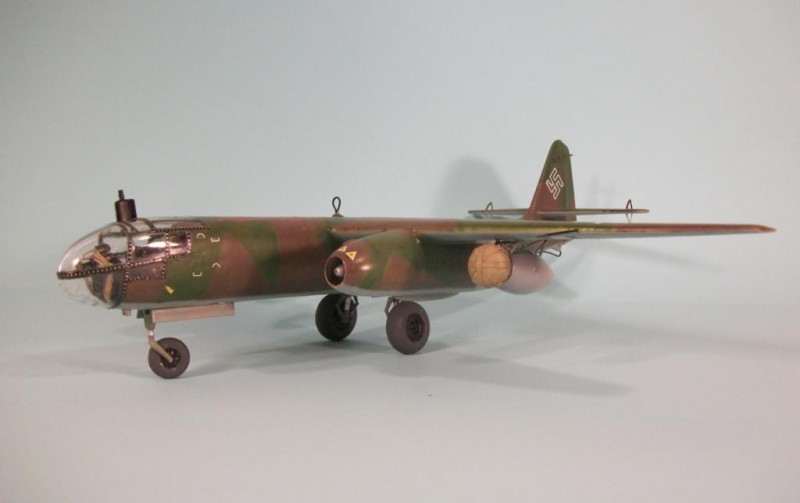
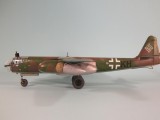
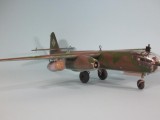
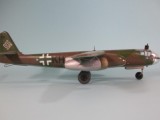
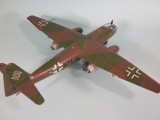
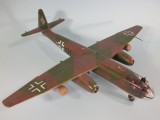

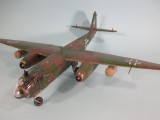
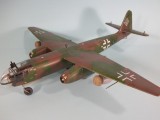
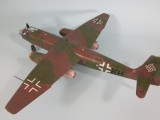
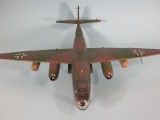
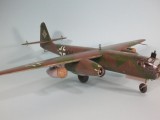
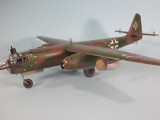
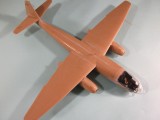
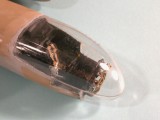
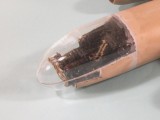


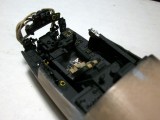
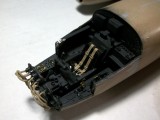
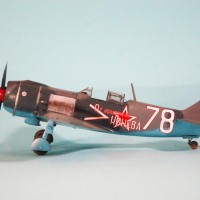
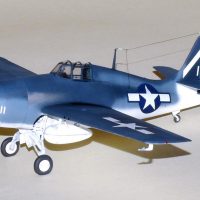

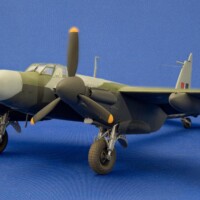
Great looking Ar 234! I've got a 72 scale version of this to build, and didn't realize (hadn't looked closely) that so much in the cockpit "hangs out" in full view - may have to do a bit more detailing than I had intended!
As always - great background info as well. Always an informative post.
Nice job and info Tom. At 1/32 that's got to be a big bird to sit on a shelf.
Nice work Tom….you obviously do not have a space problem for your completed models.
Great subject and build. Also thanks for the history 🙂 I like early jetplanes. It must be really impressive in 1/32 as I have in 1:48 and that isn't small at all.